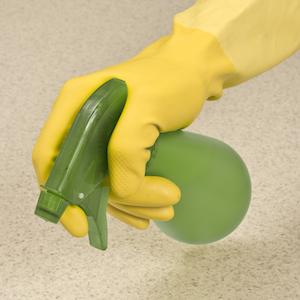Last week, international media outlets reported that asparagus causes cancer. It does not.
Like a series of bad sequels, the media is back with yet another terribly botched story. This time, the claim is that using household cleaning sprays is like smoking 20 cigarettes per day. Wrong again.
The study, which used a cohort design, examined lung capacity and function among participants who did or did not use cleaning sprays. As expected, over time, lung function declined for everybody. That's because our lungs don't function as well as we age. However, the data showed that lung capacity and function declined faster for women who were professional cleaners or who regularly cleaned the house at home.
That would be a reasonable conclusion, if it weren't for this fact reported by the authors: "No association between lung function and cleaning was seen for males."
Houston, we have a problem. The use of cleaning sprays should not have a disparate impact on men and women. Of course, biological differences between the sexes are well-documented, but it seems reasonable to assume that if chemical exposure causes lung function decline in women, it should also cause the same in men. The fact that the authors could not detect this suggests a flaw in their methodology*.
The far bigger problem is how the authors (and journalists) interpreted the study. Because the lung function decline detected in women who cleaned was similar to the lung function decline observed in smokers, the study was reported as showing that using cleaning sprays was akin to smoking. That is a ridiculous conclusion.
Yes, smoking decreases lung function. But it does a lot of other things, too, like increasing the likelihood of many types of cancer. In fact, smoking is so bad, that the National Cancer Institute warns, "Smoking harms nearly every bodily organ and organ system in the body and diminishes a person's overall health."
Is that true of cleaning sprays? Probably not. And even if it was, the study didn't address that question. It only examined lung function, not cancer or the incidence of a myriad of other diseases.
Smoking Is the Hitler of Epidemiology
Other than perhaps snorting meth or injecting heroin, there aren't many things worse for your body than smoking cigarettes. Despite this, in order to scare people, some public health officials and journalists compare everything to smoking, which is why smoking has become the Hitler of epidemiology. Just like Hitler, everything bad is compared to smoking. Stop it. That's nonsense.
Once again, if journalists were doing their jobs, the headlines would have read, "Long-term use of cleaning sprays may harm lung function." But that's not sexy. Common sense tells us that breathing in noxious fumes that cause us to cough and make our eyes water isn't a great idea. That's why cleaning sprays often come with warnings to use them only in well-ventilated areas.
Instead, we got the sexier headline equating cleaning sprays to cigarettes. The only problem is that it isn't true.
*Note: Any study that relies on self-reporting (in this case, cleaning habits) is susceptible to strange results.
Source: Øistein Svanes, et al. "Cleaning at home and at work in relation to lung function decline and airway obstruction." Am J Respir Crit Care Med. Published online before print: Feb 2018.




